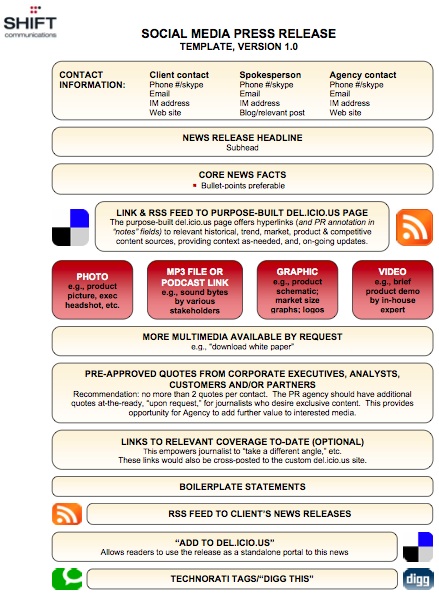What is the difference between a press release and a social media news release?
ATTRACTIVENESS, STRUCTURE and REACH to name a few. Let’s have a look.
Features compared
While a SMNR includes the elements of a traditional PRS (logo, title, facts, quotes, boiler plate, and contact information) it also adds value to its receiver through multimedia, RSS, social bookmarking and other useful links – see the pictures below.


There are a few points I want to make about the comparison:
1. “A picture is worth a million words” and one can argue that traditional press releases can also include photos. I say that opening e-mail attachments takes longer than scrolling a mouse. :)
2. A SMNR is better structured than a PRS making it easier for readers/journalists to spot the information they need.
3. The format of SMNRs is attractive (take a quick look at two photos above!). First impression always counts even if we should not “judge a book by its cover”.
4. Sharing is facilitated through SMNRs (Copyblogger).
Receivers compared
With a SMNR public relations pros can directly reach media, consumers and other social media users (Davies, 2009) while with a traditional PRS only media is directly targeted - consumers are a second audience. Not only does a social media release have a better reach but it is also more effective because messages are not filtered by gatekeepers. Consumers actually get to be exposed to unedited messages!

Still, media is a common audience for both and when talking about gatekeepers one thing is for sure: if you want to make press or social media releases appealing to the media you must make them newsworthy. Some things never change, right? :) And if we are talking about PR and journalism it is worth mentioning that Contemporarypr blogged about the An Inconvenient PR Truth campaign run by Realwire against irrelevance of public relations materials which I find very interesting.
So which of the two should we use? One of my professors once said that the answer to any question is: “It depends.” I have to agree with him on this one. :) Two of the issues to be taken into consideration are company resources (financial, video, audio etc) and receivers’ characteristics (internet users or not).





It definitely depends on who you are trying to target. Social Media is not appropriate for all organisations, such as for example the police, military, defence ministries. Thanks for sharing the template for a Social Media News Release (SMNR). I hope we learn more about it in class.
ReplyDeleteYou are right to say Social Media is not appropriate for all organisations. But I think Police can use social media if they want to reach teenagers, for example. The Romanian Police actually has a Twitter account! I however do not find it useful given the image the Romanian Police has and the ongoing tweets in reply to what they communicate using Twitter. Generally speaking Police could effectively use social media...
ReplyDeleteI think that with social media come new horizons and great opportunities, but also great responsibility and accountability. This is why a lot of organisations still prefer to conduct activities in a system defined by the traditional media world. There are obviously downsides and disadvantages for brands using the social web in their PR strategies: lack of short-term return on investment, privacy issues, negative commentary, possibility of losing control over the message, misunderstandings and so on.
ReplyDeleteHowever, in my opinion, on the long haul, ignoring the existence of social media is a clear strategy for failure. Conversations about organisations are happening online whether they are there to hear them or not. Having a Twitter or Facebook account, and knowing how to properly use it as a tool, could prove to be immensely useful even for police or military: they need to know what their public is saying about them not only to improve relationships but to possibly avoid a minor issues degenerating into a full blown crisis.
You are so right about the downsides. Indeed there are companies - utility companies for example - for which social media can generate negative comments and no control over the message to a great extent. Even though I truly value Twitter and Facebook I don't think they are suited for any kind of organization. I believe a lot of research and planning should be made before engaging into social media.
ReplyDelete